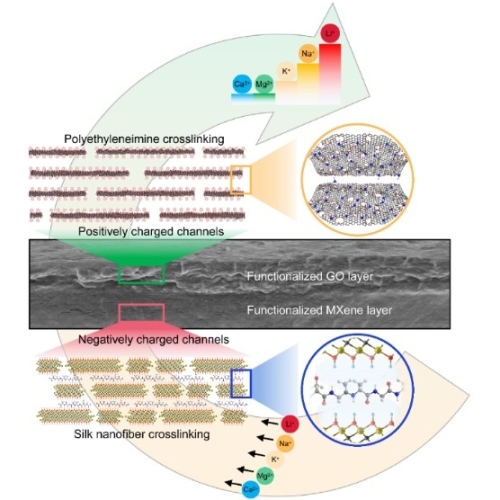The Institute of Physics and Chemistry has made progress in the research of lithium ion sieving
On December 30, 2020, Matter published the latest research results on lithium ion screening by the team of Researcher Wen Liping of the Technical Institute of Physics and Chemistry of the Chinese Academy of Sciences and Associate Professor Zhang Qianfan of Beihang University. As an important resource, lithium ion screening and enrichment have become a research hotspot. This work introduced the concept of biomimetic in the process of material synthesis, and successfully constructed a biomimetic nanocomposite membrane with a layered heterogeneous structure similar to shells using two-dimensional composite materials. This asymmetric composite membrane can effectively achieve lithium ion screening and enrichment, and provides a feasibility verification for the recovery and utilization of the key energy element lithium. In the past, scientists imitated some unique biological structures or functions to create bionic materials with recognition functions and high-strength mechanical properties. Recently, two-dimensional (2D) nanosheets have received attention and research as an emerging functional material. The nanochannels in this material can separate mixtures with different physical and chemical properties (such as size, charge polarity, and chemical affinity, etc.). In addition, nanosheets have excellent flexibility, natural pores and electrical properties, and are one of the ideal materials for large-scale production of separation membranes. Various layered materials have been successfully exfoliated and reconstructed, such as graphene oxide (GO), hexagonal boron nitride, transition metal carbides and nitrides (MXene), black phosphorus and layered clay. Among them, the unique chemical activity on the surface of the nanosheets, especially the alternating regions of hydrophobic and hydrophilic domains generated by oxygen-containing functional groups, can realize the controllable transmission of substances. However, the current two-dimensional materials cannot be stable for a long time in an aqueous solution and are prone to swelling, which affects their practical applications. Based on this, the researchers developed a simple reconstruction method to obtain nanofiber cross-linked functionalized nanosheets to form a shell-like layered structure. Due to the crosslinking effect of nanofibers, the composite membrane can effectively prevent the swelling phenomenon caused by the aqueous solution entering between the nanosheets. The mechanical performance test results show that the prepared nanosheet horizontal arrangement structure has good mechanical behavior, which exceeds the performance of the natural nacre. This feature enables the composite membrane to operate and use stably for a long time in water. The asymmetric geometric configuration and chemical properties of the composite membrane enable the extraction and sieving of lithium ions, and its Li+/Na+ and Li+/K+ selectivities reach 2.52 and 4.78, respectively, which exceed the currently reported two-dimensional material-based composites. The performance of the membrane. In addition, this composite membrane with an asymmetric structure, charge surface and chemical activity is expected to be further used in water treatment, energy conversion, and ion batteries. Diamond Electroplated Grinding Wheel DIY,special Guanghan Longrun Science and Trade Technology Trade Co., Ltd. , https://www.kairungongju.com
Ion sieving based on bionic nanochannel membrane